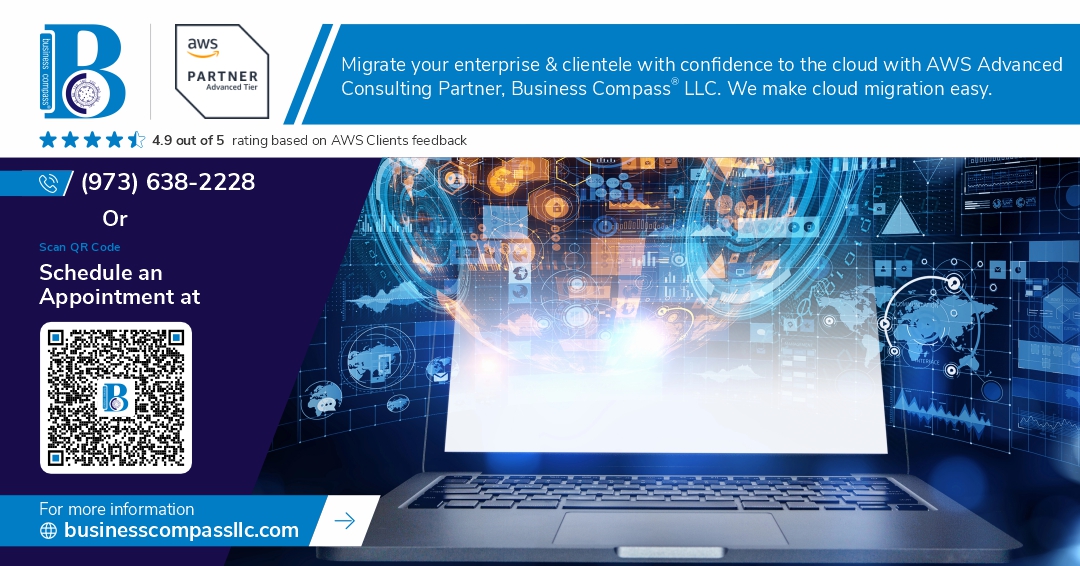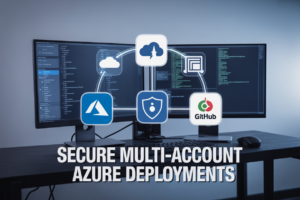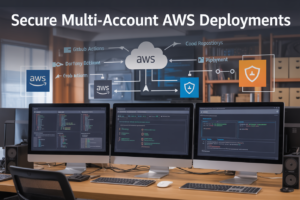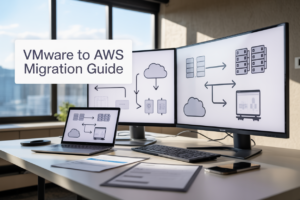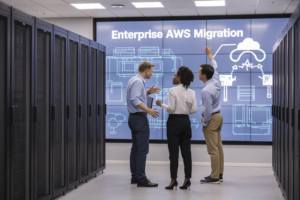Ever stared at your AWS console wondering why your perfectly coded app suddenly stopped working? You’re not alone. Most developers I talk to feel like they’re playing whack-a-mole with architecture problems they never see coming.
I’m going to walk you through the complete AWS web app architecture from DNS to data storage so you can finally visualize the entire system that makes your app run.
Understanding the flow of data through your AWS web app architecture isn’t just for DevOps specialists anymore – it’s the difference between building something that scales beautifully and creating a ticking time bomb of technical debt.
But here’s what most AWS tutorials miss completely…
DNS Management with Route 53
A. Setting up domain routing for your web application
Getting your domain to point to your AWS web app seems simple until you’re staring at Route 53’s console wondering what just happened. Trust me, we’ve all been there.
First, you’ll need to create a hosted zone in Route 53 for your domain. This costs about $0.50 per month, but the control you get is worth every penny.
aws route53 create-hosted-zone --name yourdomain.com --caller-reference 2021-01-01
Once your hosted zone is set up, you’ll need to update your domain’s name servers with your registrar. Route 53 will give you four NS records – copy these exactly as shown.
The magic happens when you create an A record pointing to your resources. For web apps behind CloudFront, create an A record with alias routing:
aws route53 change-resource-record-sets --hosted-zone-id ZXXXXX --change-batch file://change-batch.json
Don’t forget to validate your SSL certificate if you’re using HTTPS (and you should be).
B. Implementing geo-location based routing strategies
Want visitors from Tokyo to hit your Tokyo servers? Geo-routing is your answer.
Route 53 lets you create location-based routing policies that direct traffic based on where your users are. This isn’t just cool – it drastically improves load times.
To set it up:
- Create records with the same name but different routing policies
- Assign each record a geographic location
- Point each to different resources (like regional load balancers)
For example, European users might go to eu-west-1 resources, while US users hit us-east-1. You can get as granular as country-level or stay broad with continents.
The real power comes when you combine this with AWS Global Accelerator or regional CloudFront distributions.
C. Configuring health checks and failover mechanisms
Downtime happens. But does your customer need to know? Not with proper failover configuration.
Route 53 health checks monitor your endpoints every 30 seconds (by default) and can trigger automatic failover when things go south.
Creating a basic health check is straightforward:
aws route53 create-health-check --caller-reference my-health-check --health-check-config Type=HTTP,FullyQualifiedDomainName=example.com,Port=80,ResourcePath=/health
The real magic happens when you pair health checks with failover routing. Set up primary and secondary records, with the secondary only taking traffic when the primary’s health check fails.
This setup is perfect for multi-region architectures. Your Oregon region goes down? No problem – Virginia takes over automatically while you fix things.
Pro tip: Create health checks that monitor the entire request path, not just your web server. A healthy EC2 instance doesn’t mean your database is responding.
D. DNS record types and their use cases in AWS
DNS records can make or break your AWS architecture. Here’s what you’ll actually use:
| Record Type | Common Use Case in AWS |
|---|---|
| A/AAAA | Direct routing to IP addresses (IPv4/IPv6) |
| CNAME | Pointing subdomains to other domains |
| ALIAS | AWS-specific record for pointing to AWS resources |
| MX | Email routing (for WorkMail or external email) |
| TXT | Verification records and SPF for email |
The ALIAS record is unique to Route 53 and crucial for AWS setups. Unlike CNAMEs, ALIAS records work at the zone apex (naked domain) and don’t incur charges for Route 53 queries.
For web apps, you’ll most commonly use ALIAS records pointing to CloudFront distributions or ALBs. They automatically update if the underlying IP changes.
For microservices architectures, consider private hosted zones with meaningful DNS names rather than hardcoded IPs in your configs.
Frontend Architecture Options
A. Amazon CloudFront for global content delivery
CloudFront isn’t just a nice-to-have for your AWS web app—it’s practically non-negotiable if you care about user experience. This CDN service places your content at edge locations worldwide, dramatically cutting load times for users whether they’re in Tokyo or Toronto.
What makes CloudFront stand out is how it works with other AWS services. Hook it up to your S3 bucket, and boom—your static assets are cached globally. Or pair it with Application Load Balancer for dynamic content delivery that still benefits from CloudFront’s edge network.
B. S3 static website hosting capabilities
S3 is stupidly simple yet powerful for hosting static websites. Upload your HTML, CSS, and JavaScript files, flip a few switches in the console, and you’ve got a website. No servers to manage, no scaling concerns.
The real magic happens when you combine S3 with other AWS services. Your hosting costs? Pennies. Your scaling capability? Basically infinite.
C. Amplify for full-stack web application deployment
Amplify is AWS’s answer to “this cloud stuff is too complicated.” It’s like they took the most common web app patterns and turned them into a one-click solution.
With Amplify, you’re getting:
- CI/CD pipeline connected to your Git repo
- Frontend hosting with global CDN
- Backend resources provisioned automatically
- Authentication, storage, and API integrations
D. Managing SSL certificates with AWS Certificate Manager
SSL certificates used to be a pain—expensive, manual renewals, complicated installation. AWS Certificate Manager (ACM) makes this headache disappear.
Free public certificates that auto-renew? Check. Seamless integration with CloudFront and ALB? Check. No more late-night panics about expiring certs? Double check.
E. Implementing client-side caching strategies
Smart caching transforms good web apps into great ones. With CloudFront, you can set cache behaviors based on file types, paths, or query strings.
Beyond CloudFront, implement:
- Appropriate Cache-Control headers
- ETag support for conditional requests
- Service workers for offline capabilities
The best part? AWS handles the heavy lifting while you focus on user experience.
API Gateway and Request Processing
RESTful API Design Principles in AWS
API Gateway doesn’t care if your API follows RESTful principles, but your developers sure will. Following REST in AWS means organizing your resources logically (like /users/{userId}/orders), using HTTP methods correctly (GET for reading, POST for creating), and returning appropriate status codes.
The sweet spot? Structure your API Gateway resources to mirror your business domain. Instead of /api/v1/getUser, use /api/v1/users/{id}. Your front-end team will thank you later.
Here’s a quick cheat sheet:
| Operation | HTTP Method | API Gateway Path | Lambda Function |
|---|---|---|---|
| Get all users | GET | /users | getAllUsers |
| Get one user | GET | /users/{id} | getUserById |
| Create user | POST | /users | createUser |
| Update user | PUT | /users/{id} | updateUser |
Securing APIs with Authentication and Authorization
Security isn’t optional in AWS. API Gateway gives you multiple ways to lock down your APIs:
- API Keys: Basic but limited. Good for simple rate limiting.
- IAM Roles: Perfect when both your client and API are AWS-native.
- Cognito User Pools: The go-to for web/mobile apps with real user accounts.
- Lambda Authorizers: Your custom security logic when the built-in options don’t cut it.
Most web apps need a combo approach. Cognito handles your user login flows, while Lambda Authorizers let you implement complex permission checks like “can this user edit this specific resource?”
Implementing Request Validation and Transformation
Garbage in, garbage out doesn’t fly in production. API Gateway’s request validators catch malformed requests before they hit your Lambdas.
Set up JSON Schema validation in your API definition to automatically reject requests missing required fields. For more complex validation, use mapping templates to transform requests before they reach your backend.
A mapping template like this:
{
"userId": "$input.params('user_id')",
"timestamp": "$context.requestTime"
}
Can turn a messy client request into exactly what your Lambda expects.
API Versioning Strategies for Backward Compatibility
Breaking your API means breaking your client apps. AWS doesn’t force any versioning strategy on you, but you’ve got options:
- URI versioning:
/api/v1/users→ simple but means duplicating resources - Custom headers:
X-API-Version: 2→ cleaner URIs but harder to discover - Content negotiation:
Accept: application/vnd.myapi.v2+json→ most RESTful approach
Whichever you choose, set up separate stages in API Gateway (dev/staging/prod) and use AWS CloudFormation to manage deployments. This lets you roll back quickly when that “minor change” accidentally breaks everything.
Compute Options for Business Logic
Serverless architecture with AWS Lambda
Who wants to manage servers in 2023? Not me, and probably not you either. AWS Lambda lets you run code without the server headache. Upload your code, and it runs when triggered—end of story. Perfect for APIs, data processing, or automated tasks that don’t need to run 24/7.
The beauty? You pay only when your code executes. Your function sits idle? You pay nothing.
function handleRequest(event, context) {
// Your business logic here
return { statusCode: 200, body: "Success!" };
}
Container-based solutions with ECS and EKS
Got complex apps that need consistent environments? Containers are your best friend.
ECS is AWS’s native container service—simple to use but powerful enough for most workloads. EKS gives you full Kubernetes without the setup nightmare.
Quick comparison:
| Service | Best For | Learning Curve |
|---|---|---|
| ECS | AWS-native teams, simpler workloads | Moderate |
| EKS | Kubernetes experts, complex orchestration | Steep |
Traditional EC2 instances for specialized workloads
Sometimes you just need raw computing power. Maybe your app needs specific hardware configurations, custom kernel modules, or legacy software that won’t containerize nicely.
EC2 instances give you that complete control. Pick your instance type, install what you need, and configure it exactly how you want.
Auto-scaling strategies to handle traffic fluctuations
Traffic spikes happen. Be ready.
- Target tracking scaling: “Keep my CPU at 70%”
- Step scaling: “Add 2 instances when CPU exceeds 80%”
- Scheduled scaling: “Double capacity before Black Friday”
Auto-scaling groups work across EC2, ECS, and even with Lambda concurrency limits.
Cost optimization techniques for compute resources
Nobody wants a shocking AWS bill. Try these:
- Use Spot Instances for non-critical workloads (up to 90% savings)
- Right-size your instances (AWS Cost Explorer helps identify waste)
- Implement automatic start/stop schedules for dev environments
- Use Lambda provisioned concurrency only during peak periods
- Set up billing alerts before things get out of hand
Data Storage and Management
A. Choosing between RDS, DynamoDB, and Aurora
Picking the right database for your AWS app isn’t just a technical decision—it’s about matching your data needs with the right tool.
RDS gives you the comfort of familiar relational databases (MySQL, PostgreSQL, etc.) with AWS handling the boring operational stuff. Perfect when you need complex queries and ACID compliance.
DynamoDB is AWS’s NoSQL powerhouse. It shines when you need:
- Lightning-fast, consistent performance regardless of scale
- Simple key-value or document access patterns
- Pay-as-you-go pricing without capacity planning headaches
Aurora takes MySQL and PostgreSQL to the next level with:
| Feature | Benefit |
|---|---|
| 5× performance of standard MySQL | Handle more traffic without sweating |
| Distributed storage architecture | 6 copies of your data across 3 AZs |
| Auto-scaling storage | No more 2am disk space emergencies |
Your choice boils down to: Do you need SQL’s rich query capabilities (RDS/Aurora) or DynamoDB’s raw speed and simplicity?
B. Implementing data caching with ElastiCache
Database calls are expensive. ElastiCache slashes response times by putting frequently accessed data in memory.
Two flavors to pick from:
- Redis: The Swiss Army knife. Great for complex data types, sorted sets, pub/sub, and when you need persistence
- Memcached: The speed demon. Simpler, multi-threaded, and perfect for caching HTML fragments
C. Object storage solutions with S3
S3 isn’t just storage—it’s the backbone of countless AWS architectures. Need to store images, videos, backups, or static websites? S3’s your answer.
Smart architects use S3 storage classes to optimize costs:
- Standard for frequent access
- Infrequent Access for backups
- Glacier for archives you rarely touch
- Intelligent-Tiering when access patterns are unpredictable
D. Data backup and disaster recovery strategies
Disasters happen. The question is: how quickly can you recover?
Your AWS backup strategy should include:
- Automated RDS snapshots
- Cross-region S3 replication
- DynamoDB point-in-time recovery
- AMI backups for EC2 instances
Define your Recovery Time Objective (RTO) and Recovery Point Objective (RPO) first, then build your strategy around those numbers. Don’t wait for a disaster to test your recovery plan—schedule regular drills.
Security Throughout the Architecture
A. IAM roles and policies for resource access control
Want to know the #1 security mistake AWS devs make? Giving everything admin access because it’s “easier.” Terrible idea.
Instead, lock down your resources with IAM roles and policies following the principle of least privilege. Only grant permissions absolutely necessary for each component to function.
For your web app, create specific IAM roles for:
- EC2 instances (to access S3, DynamoDB, etc.)
- Lambda functions (with fine-grained API permissions)
- Application services (restricting database access)
Use resource-based policies where possible and condition statements to further restrict access based on IP ranges, time of day, or required MFA.
B. Implementing WAF to protect against common web threats
Your shiny new web app is basically waving a “hack me” flag without proper protection. AWS WAF acts as your bouncer, filtering malicious traffic before it reaches your application.
Configure WAF to defend against:
- SQL injection attempts
- Cross-site scripting (XSS)
- Geographic restrictions (block traffic from suspicious regions)
- Rate-limiting to prevent DDoS attacks
The magic of WAF? You can customize rules based on request patterns, IP addresses, or even specific HTTP headers.
C. Network security with VPC, security groups, and NACLs
Think of your VPC as your app’s private neighborhood. Security groups are your locks on each door, while NACLs are the neighborhood gates.
For robust security:
- Place database servers in private subnets with no internet access
- Use security groups as your first defense (stateful, allowing return traffic)
- Implement NACLs as your second layer (stateless, requiring explicit inbound/outbound rules)
- Create network segments with clear traffic patterns
D. Secrets management with AWS Secrets Manager
Hard-coding credentials in your application code? Stop that immediately!
AWS Secrets Manager encrypts and centrally manages database credentials, API keys, and other secrets. It automatically rotates credentials and eliminates the need for configuration files with plaintext secrets.
Best part? Your app can retrieve secrets programmatically at runtime, and you can control who has access to which secrets.
E. Compliance and security monitoring
Security isn’t a “set it and forget it” deal. Your architecture needs constant monitoring:
- AWS CloudTrail tracks API activity and changes to resources
- Amazon GuardDuty provides intelligent threat detection
- AWS Config monitors compliance with security standards
- Security Hub centralizes findings from multiple security services
Set up automated notifications for suspicious activities and regular compliance scans against frameworks like PCI-DSS, HIPAA, or GDPR depending on your industry.
Monitoring and Observability
CloudWatch for metrics, logs, and alarms
You can’t fix what you can’t see. CloudWatch is your eyes and ears inside your AWS environment. Think of it as mission control for your application – tracking everything from CPU usage to custom app metrics.
Most AWS services automatically push metrics to CloudWatch. For your EC2 instances or containers, you’ll need the CloudWatch agent installed. The real power comes when you set up custom metrics for your specific business needs, like tracking checkout failures or API response times.
Setting up CloudWatch Logs is dead simple – just point your app logs there and search them when things go wonky. The best part? You can create alarms that trigger when metrics cross thresholds you define.
aws cloudwatch put-metric-alarm \
--alarm-name "high-error-rate" \
--comparison-operator GreaterThanThreshold \
--evaluation-periods 1 \
--metric-name Errors \
--namespace "MyApplication" \
--period 60 \
--threshold 5
X-Ray for distributed tracing
Distributed tracing is your lifeline when trying to debug microservices. AWS X-Ray creates a visual map of your application’s requests, showing you exactly where things slow down or break.
X-Ray works by tracking requests across your services, giving each request a unique ID that follows it everywhere. You just need to add the X-Ray SDK to your code:
const AWSXRay = require('aws-xray-sdk');
// Then wrap your HTTP client
const https = AWSXRay.captureHTTPs(require('https'));
The service maps are a game-changer when troubleshooting. They show you the exact path a request takes through your architecture and where the bottlenecks are hiding.
Setting up effective dashboards for application health
Custom dashboards save your sanity. Don’t waste time jumping between multiple screens when things go south.
Your dashboard should include:
- Service availability metrics
- Error rates across key components
- Latency percentiles (p50, p95, p99)
- Resource utilization stats
- Business KPIs that matter to you
Group related metrics together and organize by service. The goal is getting the full picture at a glance.
I recommend starting with a high-level dashboard showing overall health, then creating drill-down dashboards for specific services that need extra attention.
Implementing alerting strategies for critical issues
Alert fatigue is real. The worst thing you can do is create so many alerts that you start ignoring them.
Follow these principles:
- Alert on symptoms, not causes (user impact vs. CPU usage)
- Define clear severity levels (P1-P4)
- Establish escalation paths for each severity
- Set up different notification channels (Slack for warnings, SMS for critical)
- Use composite alarms to reduce noise
For critical production issues, consider using AWS EventBridge to trigger auto-remediation when possible. Why wake up at 3 AM if you can have Lambda functions fixing common problems automatically?
Building a robust AWS web application requires careful planning across multiple service layers. Route 53 provides reliable DNS management, while frontend options like CloudFront and S3 deliver optimal content to users worldwide. API Gateway and Lambda functions create efficient request handling, and various compute options from serverless to containerized solutions offer flexibility based on your specific needs. Database services from RDS to DynamoDB ensure your data is properly stored and accessed, all within a comprehensive security framework.
As you architect your AWS web application, focus on creating a balanced solution that addresses your specific requirements while leveraging AWS’s managed services to reduce operational overhead. Start with a minimum viable architecture and scale components as needed, using AWS’s monitoring tools to gain insights into performance and user experience. Whether you’re building a simple website or complex enterprise application, AWS provides the building blocks for a resilient, secure, and performant web architecture.










